Influence of Heat–Cool Cyclic Exposure on the Performance of Fiber-Reinforced High-Strength Concrete
Abstract
1. Introduction
2. Research Significance
3. Materials and Methods
3.1. Materials
3.1.1. Cement
3.1.2. Aggregates
3.1.3. Superplasticizer and Water
3.1.4. Date Palm Fibers
Chemical Treatment of Date Palm Fibers
3.1.5. Polypropylene Fibers
3.1.6. Steel Fibers
3.2. Methodology
3.2.1. Mix Design and Specimens Preparation
3.2.2. Thermal Cycles Procedure
3.2.3. Investigation of Structural Properties
Compressive Strength Test
Flexural Strength Test
Density Test
Water Absorption Capacity Test
Ultrasonic Pulse Velocity (UPV) Test
Energy Absorption Capacity
4. Results and Discussions
4.1. Compressive Strength
4.2. Flexural Strength
4.3. Density
4.4. Water Absorption Capacity
4.5. Ultrasonic Pulse Velocity
4.6. Energy Absorption Capacity
5. Conclusions
Author Contributions
Funding
Institutional Review Board Statement
Informed Consent Statement
Data Availability Statement
Acknowledgments
Conflicts of Interest
References
- Ahmmad, R.; Jumaat, M.Z.; Alengaram, U.J.; Bahri, S.; Rehman, M.A.; Bin Hashim, H. Performance evaluation of palm oil clinker as coarse aggregate in high strength lightweight concrete. J. Clean. Prod. 2016, 112, 566–574. [Google Scholar] [CrossRef]
- Hosen, M.A.; Jumaat, M.Z.; Islam, A.S. Side Near Surface Mounted (SNSM) technique for flexural enhancement of RC beams. Mater. Des. 2015, 83, 587–597. [Google Scholar] [CrossRef]
- Hakeem, I.Y.; Amin, M.; Zeyad, A.M.; Tayeh, B.A.; Maglad, A.M.; Agwa, I.S. Effects of nano sized sesame stalk and rice straw ashes on high-strength concrete properties. J. Clean. Prod. 2022, 370, 133542. [Google Scholar] [CrossRef]
- Ma, C.-K.; Apandi, N.M.; Sofrie, C.S.Y.; Ng, J.H.; Lo, W.H.; Awang, A.Z.; Omar, W. Repair and rehabilitation of concrete structures using confinement: A review. Constr. Build. Mater. 2017, 133, 502–515. [Google Scholar] [CrossRef]
- Hakeem, I.Y.; Agwa, I.S.; Tayeh, B.A.; Abd-Elrahman, M.H. Effect of using a combination of rice husk and olive waste ashes on high-strength concrete properties. Case Stud. Constr. Mater. 2022, 17, e01486. [Google Scholar] [CrossRef]
- Hakeem, I.Y.; Amin, M.; Abdelsalam, B.A.; Tayeh, B.A.; Althoey, F.; Agwa, I.S. Effects of nano-silica and micro-steel fiber on the engineering properties of ultra-high performance concrete. Struct. Eng. Mech. 2022, 82, 295–312. [Google Scholar]
- Ali, B.; Qureshi, L.A. Influence of glass fibers on mechanical and durability performance of concrete with recycled aggregates. Constr. Build. Mater. 2019, 228, 116783. [Google Scholar] [CrossRef]
- Koushkbaghi, M.; Kazemi, M.J.; Mosavi, H.; Mohseni, E. Acid resistance and durability properties of steel fiber-reinforced concrete incorporating rice husk ash and recycled aggregate. Constr. Build. Mater. 2019, 202, 266–275. [Google Scholar] [CrossRef]
- Ahmad, S.; Hakeem, I.; Maslehuddin, M. Development of an optimum mixture of ultra-high performance concrete. Eur. J. Environ. Civ. Eng. 2016, 20, 1106–1126. [Google Scholar] [CrossRef]
- Azad, A.K.; Hakeem, I.Y. Flexural behavior of hybrid hollow-core slab built with ultra high performance concrete faces. Mater. Struct. 2016, 49, 3801–3813. [Google Scholar] [CrossRef]
- Richard, P.; Cheyrezy, M. Composition of reactive powder concretes. Cem. Concr. Res. 1995, 25, 1501–1511. [Google Scholar] [CrossRef]
- Amin, M.; Hakeem, I.Y.; Zeyad, A.M.; Tayeh, B.A.; Maglad, A.M.; Agwa, I.S. Influence of recycled aggregates and carbon nanofibres on properties of ultra-high-performance concrete under elevated temperatures. Case Stud. Constr. Mater. 2022, 16, e01063. [Google Scholar] [CrossRef]
- Ahmad, S.; Hakeem, I.; Maslehuddin, M. Development of UHPC mixtures utilizing natural and industrial waste materials as partial replacements of silica fume and sand. Sci. World J. 2014, 2014, 713531. [Google Scholar] [CrossRef] [PubMed]
- Bajaber, M.; Hakeem, I. UHPC evolution, development, and utilization in construction: A review. J. Mater. Res. Technol. 2021, 10, 1058–1074. [Google Scholar] [CrossRef]
- Ahmad, S.; Hakeem, I.; Azad, A.K. Effect of curing, fibre content and exposures on compressive strength and elasticity of UHPC. Adv. Cem. Res. 2015, 27, 233–239. [Google Scholar] [CrossRef]
- Hakeem, I.; Azad, A.K.; Ahmad, S. Effect of steel fibers and thermal cycles on fracture properties of ultra-high-performance concrete. J. Test. Eval. 2013, 41, 458–464. [Google Scholar] [CrossRef]
- Kaur, P.; Talwar, M. Different types of Fibres used in FRC. Int. J. Adv. Res. Comput. Sci. 2017, 8, 380–383. [Google Scholar] [CrossRef]
- Althoey, F.; Zaid, O.; de-Prado-Gil, J.; Palencia, C.; Ali, E.; Hakeem, I.; Martínez-García, R. Impact of sulfate activation of rice husk ash on the performance of high strength steel fiber reinforced recycled aggregate concrete. J. Build. Eng. 2022, 54, 104610. [Google Scholar] [CrossRef]
- Nassiri, S.; AlShareedah, O.; Rodin, H.; Englund, K. Mechanical and durability characteristics of pervious concrete reinforced with mechanically recycled carbon fiber composite materials. Mater. Struct. 2021, 54, 107. [Google Scholar] [CrossRef]
- Mansur de Castro Silva, R.; de Andrade Silva, F. Carbon textile reinforced concrete: Materials and structural analysis. Mater. Struct. 2020, 53, 17. [Google Scholar] [CrossRef]
- Minnaugh, P.L.; Harries, K.A. Fatigue behavior of externally bonded steel fiber reinforced polymer (SFRP) for retrofit of reinforced concrete. Mater. Struct. 2009, 42, 271–278. [Google Scholar] [CrossRef]
- Iqbal, S.; Ali, I.; Room, S.; Khan, S.A.; Ali, A. Enhanced mechanical properties of fiber reinforced concrete using closed steel fibers. Mater. Struct. 2019, 52, 56. [Google Scholar] [CrossRef]
- Peled, A.; Jones, J.; Shah, S.P. Effect of matrix modification on durability of glass fiber reinforced cement composites. Mater. Struct. 2005, 38, 163–171. [Google Scholar] [CrossRef]
- Hussain, I.; Ali, B.; Akhtar, T.; Jameel, M.S.; Raza, S.S. Comparison of mechanical properties of concrete and design thickness of pavement with different types of fiber-reinforcements (steel, glass, and polypropylene). Case Stud. Constr. Mater. 2020, 13, e00429. [Google Scholar] [CrossRef]
- Suksiripattanapong, C.; Phetprapai, T.; Singsang, W.; Phetchuay, C.; Thumrongvut, J.; Tabyang, W. Utilization of Recycled Plastic Waste in Fiber Reinforced Concrete for Eco-Friendly Footpath and Pavement Applications. Sustainability 2022, 14, 6839. [Google Scholar] [CrossRef]
- Ahmad, W.; Farooq, S.H.; Usman, M.; Khan, M.; Ahmad, A.; Aslam, F.; Yousef, R.A.; Abduljabbar, H.A.; Sufian, M. Effect of coconut fiber length and content on properties of high strength concrete. Materials 2020, 13, 1075. [Google Scholar] [CrossRef]
- Chin, S.C.; Tee, K.F.; Tong, F.S.; Doh, S.I.; Gimbun, J. External strengthening of reinforced concrete beam with opening by bamboo fiber reinforced composites. Mater. Struct. 2020, 53, 141. [Google Scholar] [CrossRef]
- Hawreen, A.; Bogas, J.; Kurda, R. Mechanical characterization of concrete reinforced with different types of carbon nanotubes. Arab. J. Sci. Eng. 2019, 44, 8361–8376. [Google Scholar] [CrossRef]
- Geng, K.; Chai, J.; Qin, Y.; Li, X.; Duan, M.; Liang, D. Exploring the brittleness and fractal characteristics of basalt fiber reinforced concrete under impact load based on the principle of energy dissipation. Mater. Struct. 2022, 55, 78. [Google Scholar] [CrossRef]
- Wu, Z.; Shi, C.; He, W.; Wu, L. Effects of steel fiber content and shape on mechanical properties of ultra high performance concrete. Constr. Build. Mater. 2016, 103, 8–14. [Google Scholar] [CrossRef]
- Alabduljabbar, H.; Alyousef, R.; Alrshoudi, F.; Alaskar, A.; Fathi, A.; Mustafa Mohamed, A. Mechanical effect of steel fiber on the cement replacement materials of self-compacting concrete. Fibers 2019, 7, 36. [Google Scholar] [CrossRef]
- Azad, A.K.; Ahmad, S.; Hakeem, I. Effect of cyclic exposure and fibre content on tensile properties of ultra-high-performance concrete. Adv. Cem. Res. 2013, 25, 273–280. [Google Scholar] [CrossRef]
- Lantsoght, E.O. How do steel fibers improve the shear capacity of reinforced concrete beams without stirrups? Compos. Part B Eng. 2019, 175, 107079. [Google Scholar] [CrossRef]
- Torres, J.A.; Lantsoght, E.O. Influence of fiber content on shear capacity of steel fiber-reinforced concrete beams. Fibers 2019, 7, 102. [Google Scholar] [CrossRef]
- Abambres, M.; Lantsoght, E.O. ANN-based shear capacity of steel fiber-reinforced concrete beams without stirrups. Fibers 2019, 7, 88. [Google Scholar] [CrossRef]
- Mishra, S.; Mohanty, A.; Drzal, L.; Misra, M.; Parija, S.; Nayak, S.; Tripathy, S. Studies on mechanical performance of biofibre/glass reinforced polyester hybrid composites. Compos. Sci. Technol. 2003, 63, 1377–1385. [Google Scholar] [CrossRef]
- Mohanty, A.K.; Misra, M.; Drzal, L. Sustainable bio-composites from renewable resources: Opportunities and challenges in the green materials world. J. Polym. Environ. 2002, 10, 19–26. [Google Scholar] [CrossRef]
- Priya, S.P.; Ramakrishna, H.; Rai, S.; Rajulu, A.V. Tensile, flexural, and chemical resistance properties of waste silk fabric-reinforced epoxy laminates. J. Reinf. Plast. Compos. 2005, 24, 643–648. [Google Scholar] [CrossRef]
- Althoey, F.; Hakeem, I.Y.; Hosen, M.; Qaidi, S.; Isleem, H.F.; Hadidi, H.; Shahapurkar, K.; Ahmad, J.; Ali, E. Behavior of Concrete Reinforced with Date Palm Fibers. Materials 2022, 15, 7923. [Google Scholar] [CrossRef]
- Althoey, F.; Hosen, M. Physical and mechanical characteristics of sustainable concrete comprising industrial waste materials as a replacement of conventional aggregate. Sustainability 2021, 13, 4306. [Google Scholar] [CrossRef]
- ASTM C150/C150M-22; Standard Specification for Portland Cement. ASTM: West Conshohocken, PA, USA, 2022.
- Hakeem, I.Y.; Rahman, M.K.; Althoey, F. Experimental Investigation of Hybrid Beams Utilizing Ultra-High Performance Concrete (UHPC) as Tension Reinforcement. Materials 2022, 15, 5619. [Google Scholar] [CrossRef] [PubMed]
- ASTM C1602/C1602M; Standard Specification for Mixing Water Used in the Production of Hydraulic Cement Concrete. ASTM International: West Conshohocken, PA, USA, 2018.
- C109/C109M-20b; Standard Test Method for Compressive Strength of Hydraulic Cement Mortars. ASTM: West Conshohocken, PA, USA, 2020.
- C293/C293M-16; Standard Test Method for Flexural Strength of Concrete (Using Simple Beam with Center-Point Loading). ASTM International: West Conshohocken, PA, USA, 2016.
- C138/C138M-17a; Standard Test Method for Density (Unit Weight), Yield, and Air Content (Gravimetric) of Concrete. ASTM International: West Conshohocken, PA, USA, 2017.
- BS 1881-122:2011; Testing Concrete-Part 122: Method for Determination of Water Absorption. British Standards Institution: London, UK, 1998.
- Hosen, M.A.; Shammas, M.I.; Shill, S.K.; Jumaat, M.Z.; Alengaram, U.J.; Ahmmad, R.; Althoey, F.; Islam, A.S.; Lin, Y. Investigation of structural characteristics of palm oil clinker based high-strength lightweight concrete comprising steel fibers. J. Mater. Res. Technol. 2021, 15, 6736–6746. [Google Scholar] [CrossRef]
- ASTM C597-16; Standard Test Method for Pulse Velocity Through Concrete. ASTM International: West Conshohocken, PA, USA, 2016.
- Hosen, M.A.; Jumaat, M.Z.; Alengaram, U.J.; Sulong, N.R. CFRP strips for enhancing flexural performance of RC beams by SNSM strengthening technique. Constr. Build. Mater. 2018, 165, 28–44. [Google Scholar] [CrossRef]
- Hosen, M.A.; Shammas, M.I.; Shill, S.K.; Al-Deen, S.; Jumaat, M.Z.; Hashim, H. Ductility Enhancement of Sustainable Fibrous-Reinforced High-Strength Lightweight Concrete. Polymers 2022, 14, 727. [Google Scholar] [CrossRef] [PubMed]
- Mishra, R.K.; Behera, B.K.; Chandan, V.; Nazari, S.; Muller, M. Modeling and Simulation of Mechanical Performance in Textile Structural Concrete Composites Reinforced with Basalt Fibers. Polymers 2022, 14, 4108. [Google Scholar] [CrossRef]
- Ralegaonkar, R.; Gavali, H.; Aswath, P.; Abolmaali, S. Application of chopped basalt fibers in reinforced mortar: A review. Constr. Build. Mater. 2018, 164, 589–602. [Google Scholar] [CrossRef]
- Meskhi, B.; Beskopylny, A.N.; Stel’makh, S.A.; Shcherban’, E.M.; Mailyan, L.R.; Beskopylny, N.; Chernil’nik, A.; El’shaeva, D. Insulation Foam Concrete Nanomodified with Microsilica and Reinforced with Polypropylene Fiber for the Improvement of Characteristics. Polymers 2022, 14, 4401. [Google Scholar] [CrossRef]
- Kriker, A.; Debicki, G.; Bali, A.; Khenfer, M.; Chabannet, M. Mechanical properties of date palm fibres and concrete reinforced with date palm fibres in hot-dry climate. Cem. Concr. Compos. 2005, 27, 554–564. [Google Scholar] [CrossRef]
- Azad, A.K.; Hakeem, I.Y. Flexural behavior of hybrid concrete beams reinforced with ultra-high performance concrete bars. Constr. Build. Mater. 2013, 49, 128–133. [Google Scholar] [CrossRef]
- De Schutter, G.; Audenaert, K. Evaluation of water absorption of concrete as a measure for resistance against carbonation and chloride migration. Mater. Struct. 2004, 37, 591–596. [Google Scholar] [CrossRef]
- Neville, A.M. Properties of Concrete; Longman: London, UK, 1995; Volume 4. [Google Scholar]
- Bu, C.; Zhu, D.; Lu, X.; Liu, L.; Sun, Y.; Yu, L.; Xiao, T.; Zhang, W. Modification of Rubberized Concrete: A Review. Buildings 2022, 12, 999. [Google Scholar] [CrossRef]
- Zeyad, A.M.; Hakeem, I.Y.; Amin, M.; Tayeh, B.A.; Agwa, I.S. Effect of aggregate and fibre types on ultra-high-performance concrete designed for radiation shielding. J. Build. Eng. 2022, 58, 104960. [Google Scholar] [CrossRef]
- Althoey, F.; El-Aal, A.K.A.; Shoukry, H.; Hakeem, I. Performance of Cement Mortars Containing Clay Exposed to High Temperature. Arab. J. Sci. Eng. 2022, 47, 591–599. [Google Scholar] [CrossRef]
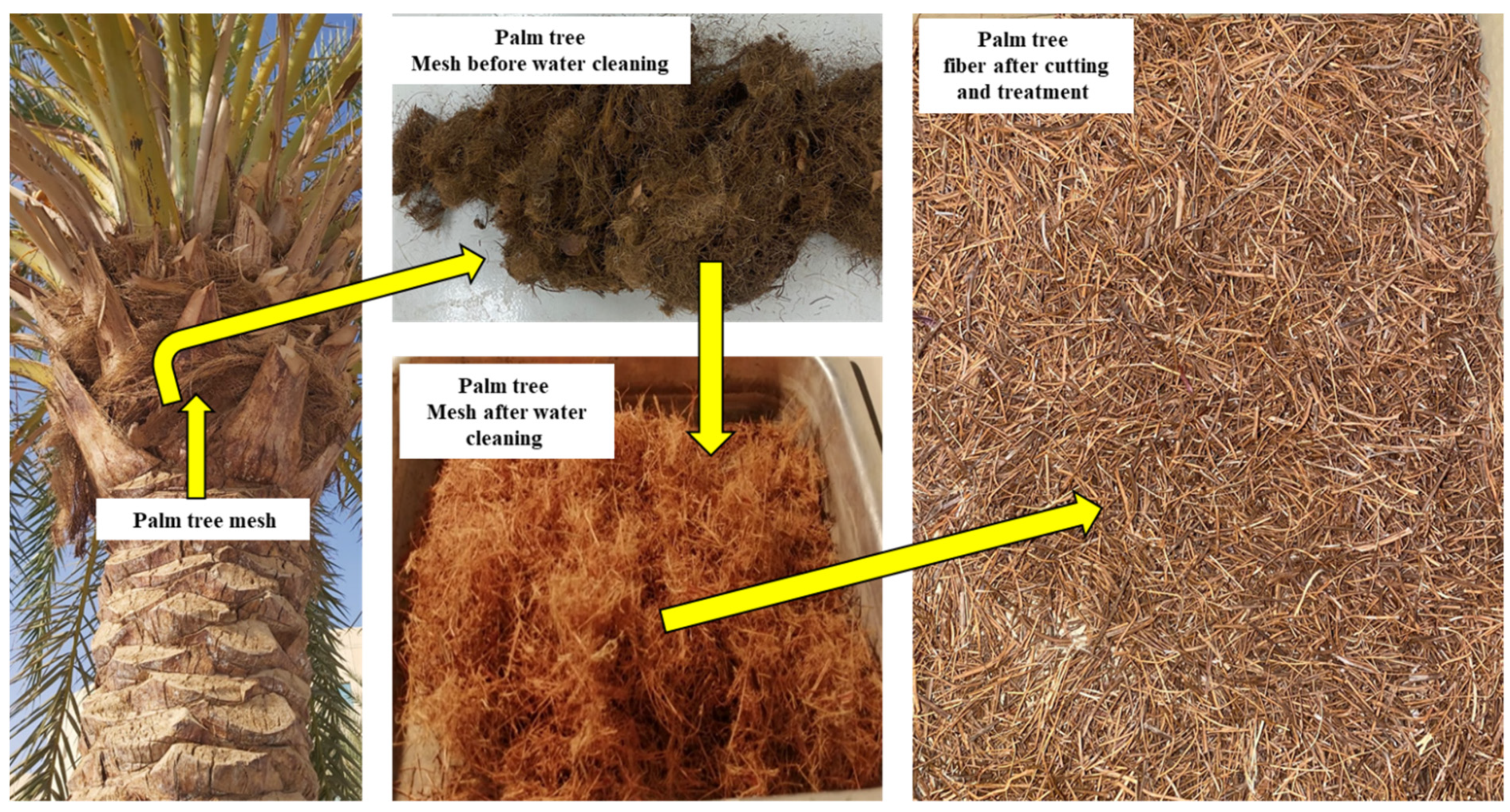
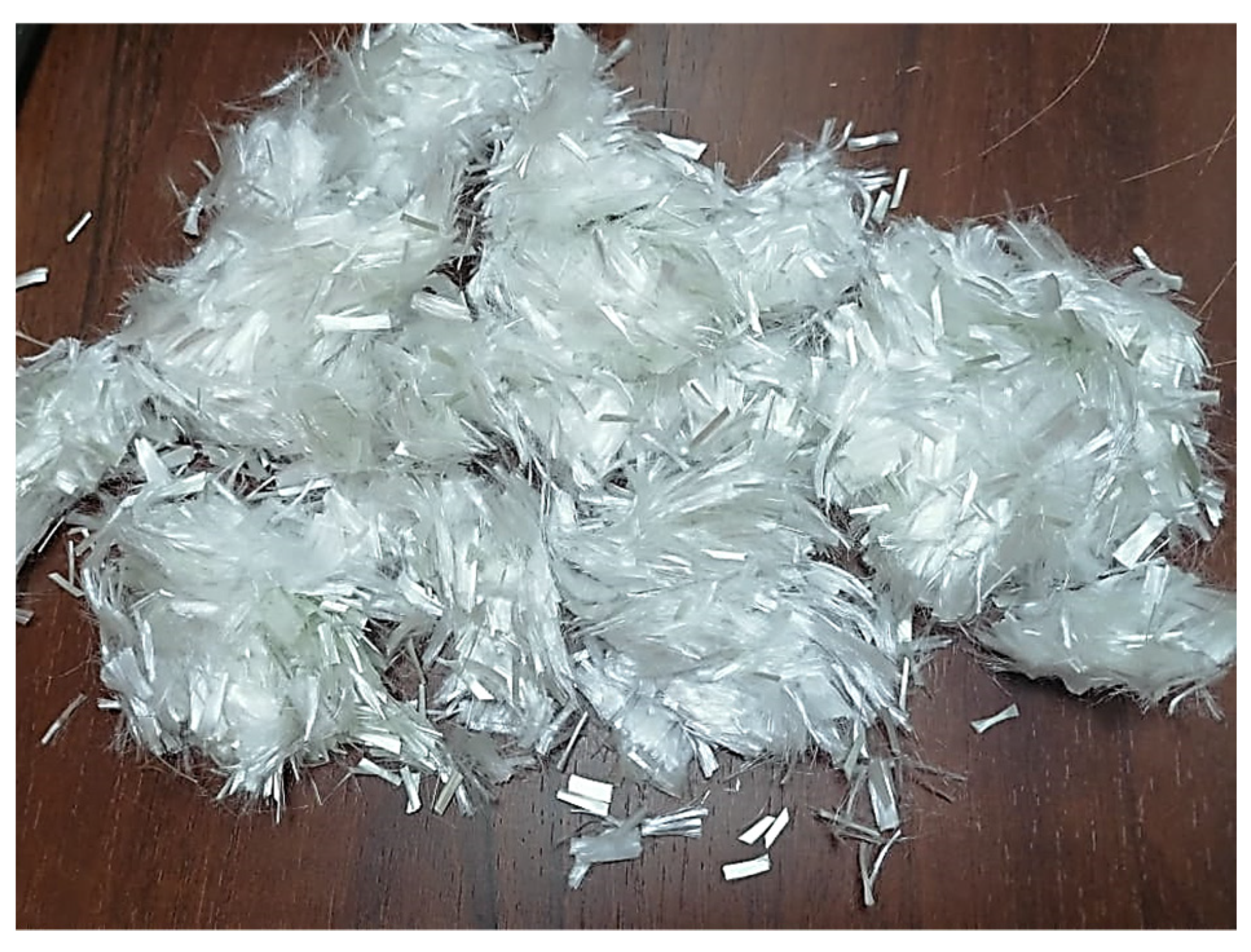

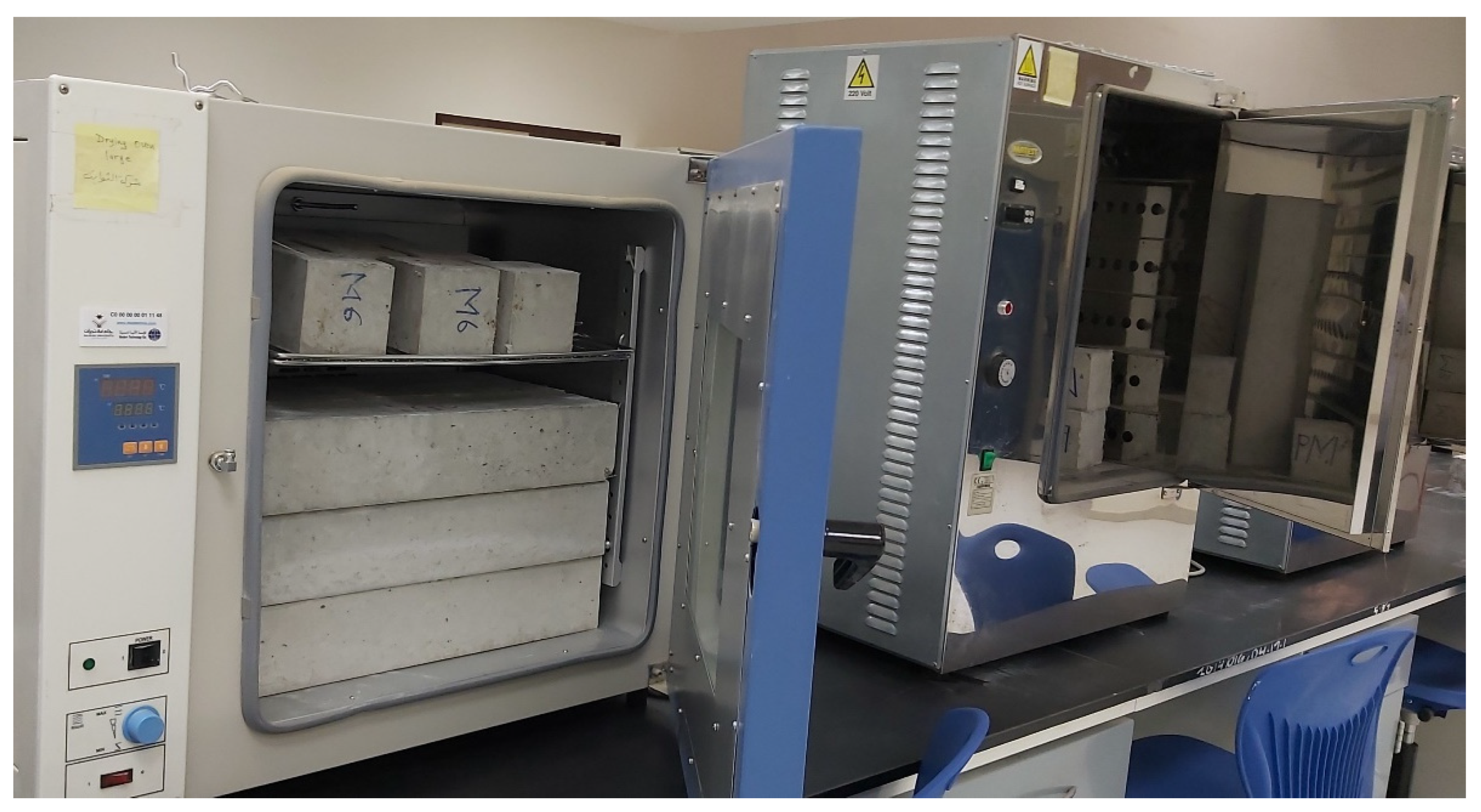


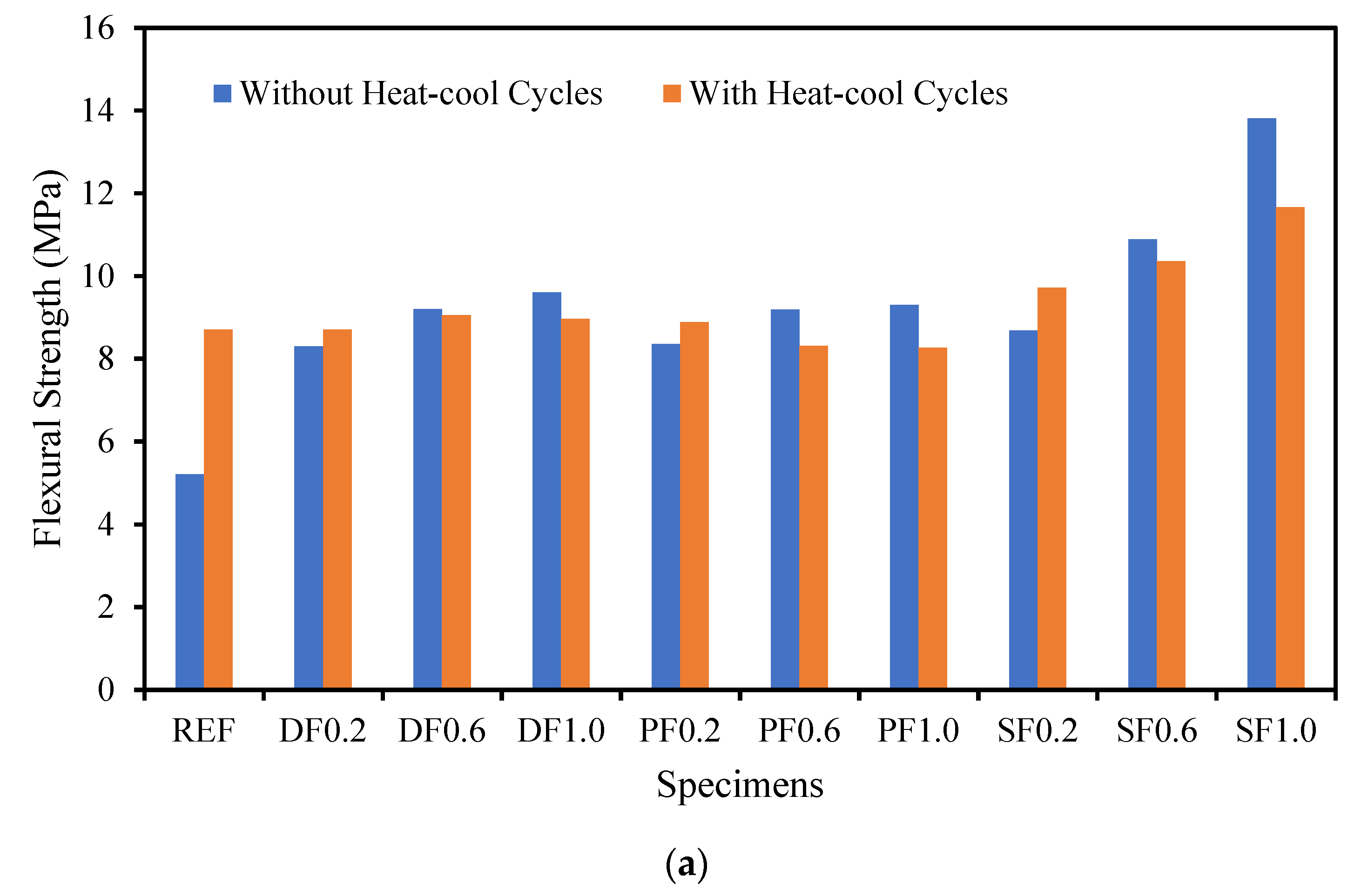
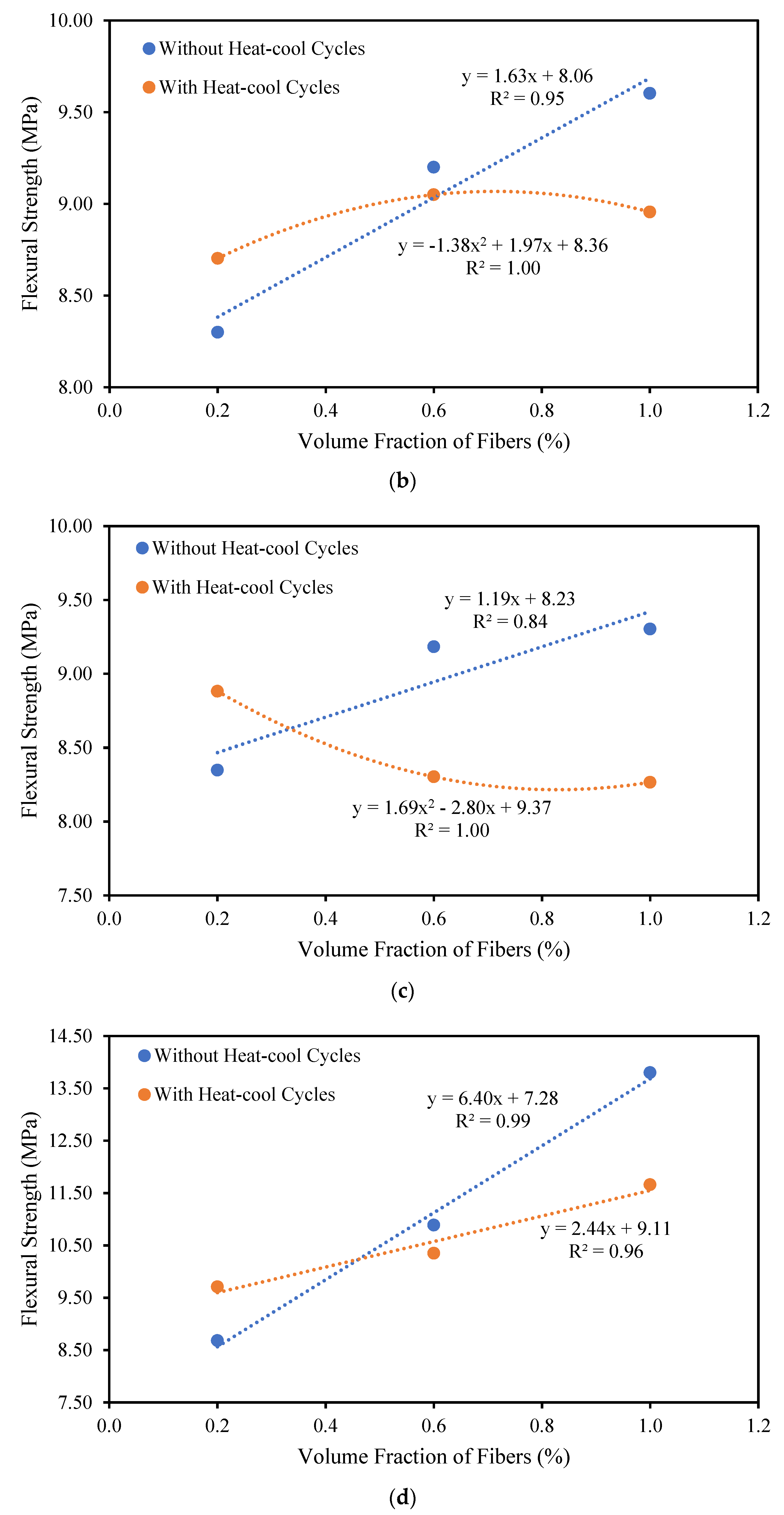
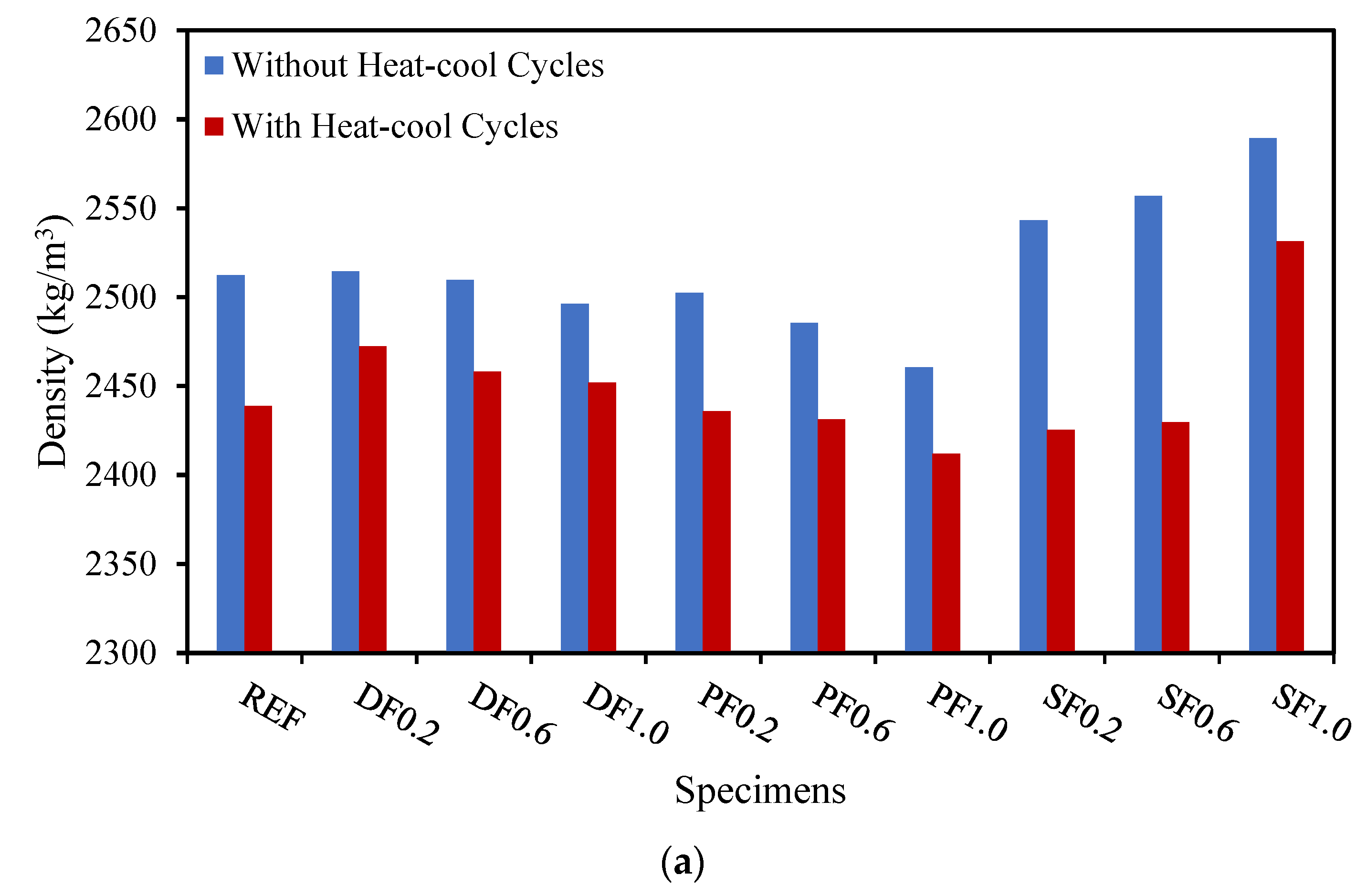


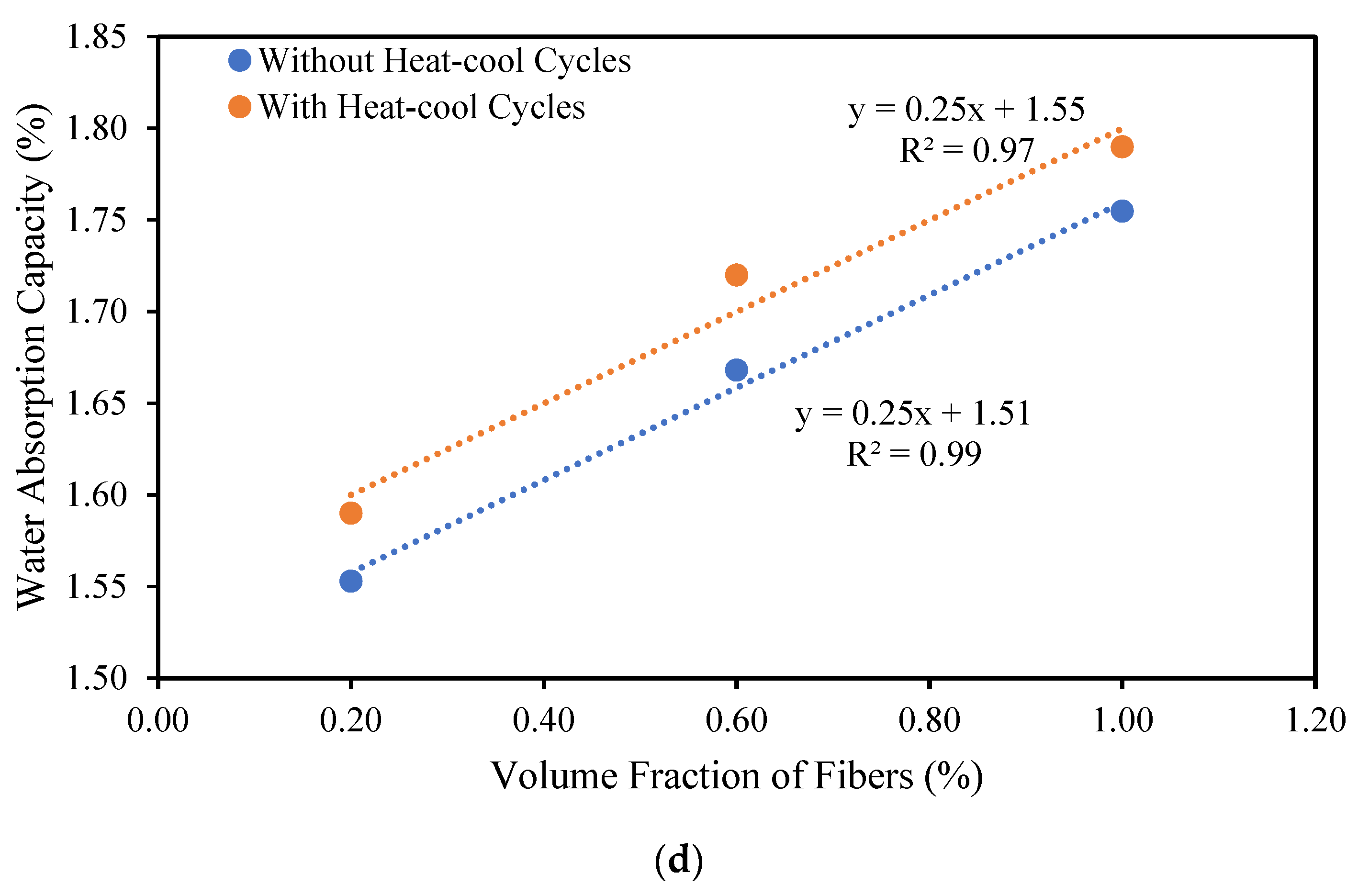

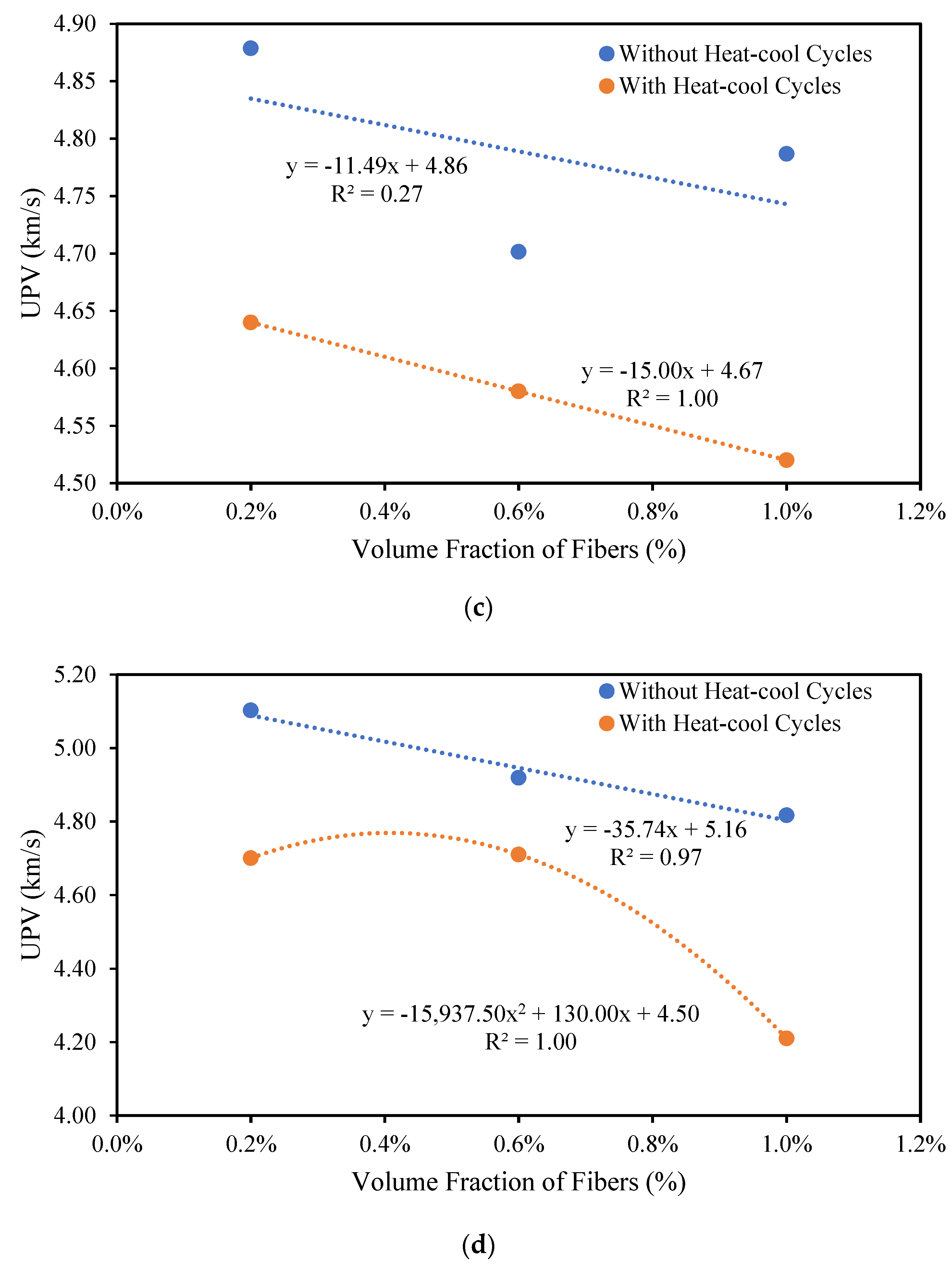
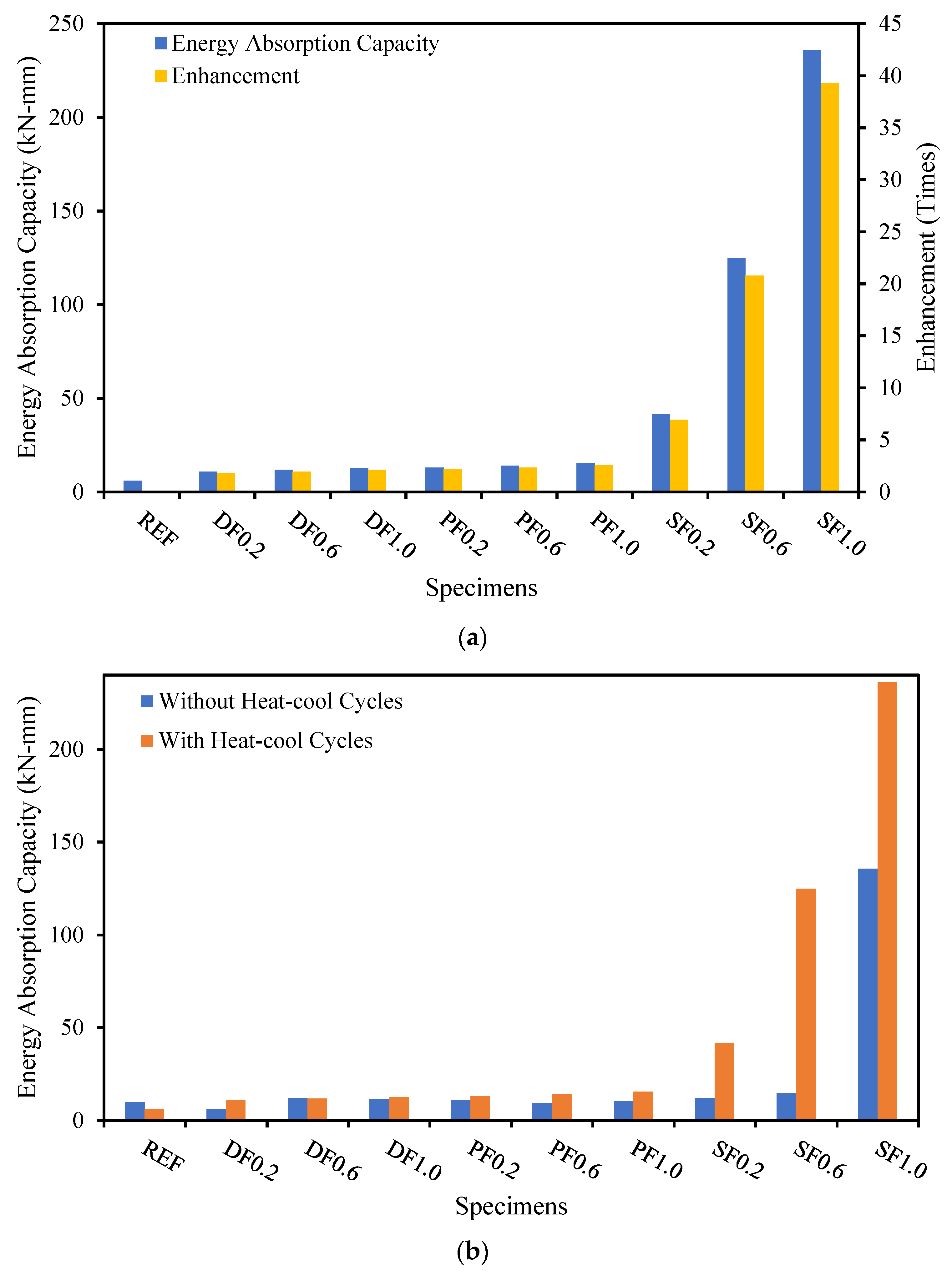
| Chemical Composite | Cao | Al2O3 | Fe2O3 | MgO | SiO2 | SO3 | LOI | K2O | Insoluble |
|---|---|---|---|---|---|---|---|---|---|
| Mass (%) | 63.83 | 6.25 | 3.45 | 0.97 | 19.70 | 2.25 | 1.52 | 1.08 | 0.95 |
| Characteristics | Type of Aggregate | |
|---|---|---|
| Fine | Coarse | |
| Bulk Density (kg/m3) | 1535.74 | 1630.00 |
| Specific Gravity | 2.67 | 2.77 |
| Fineness Modulus | 2.23 | 7.34 |
| Water Absorption (%) | 1.31 | 0.69 |
| Type of Date Palm Fibers | Diameter, (mm) | Length (mm) | Elongation (%) | Strain | Tensile Strength (MPa) |
|---|---|---|---|---|---|
| Raw Fibers | 0.90 | 92 | 4 | 0.044 | 100 |
| 1.5% NaOH Treated | 0.65 | 79 | 6 | 0.058 | 174 |
| 3.0% NaOH Treated | 0.61 | 79 | 6 | 0.062 | 234 |
| 6.0% NaOH Treated | 0.69 | 80 | 5 | 0.055 | 181 |
| Length (cm) | Diameter (cm) | Density (g/cm3) | Young Modulus (GPa) | Elongation at Breaking (%) | Tensile Strength (MPa) |
|---|---|---|---|---|---|
| 1.20 | 0.0025 | 0.91 | 5.4 | 30 | 550 |
| Length (cm) | Diameter (cm) | Aspect Ratio | Density (g/cm3) | Tensile Strength (MPa) |
|---|---|---|---|---|
| 6.0 | 0.075 | 80 | 7.85 | 625 |
| Mix ID | Fibers | Aggregates | Cement | Water | SP | ||||
|---|---|---|---|---|---|---|---|---|---|
| (%) | Date Palm | PP | Steel | Fine | Coarse | ||||
| Kilogram per Cubic Metre | |||||||||
| REF | 0 | - | - | - | 736.93 | 1105.40 | 400.00 | 176.40 | 2.0 |
| DF0.2 | 0.2 | 8 | - | - | |||||
| DF0.6 | 0.6 | 24 | - | - | |||||
| DF1.0 | 1.0 | 40 | - | - | |||||
| PF0.2 | 0.2 | - | 8 | - | |||||
| PF0.6 | 0.6 | - | 24 | - | |||||
| PF1.0 | 1.0 | - | 40 | - | |||||
| SF0.2 | 0.2 | - | - | 8 | |||||
| SF0.6 | 0.6 | - | - | 24 | |||||
| SF1.0 | 1.0 | - | - | 40 | |||||
Disclaimer/Publisher’s Note: The statements, opinions and data contained in all publications are solely those of the individual author(s) and contributor(s) and not of MDPI and/or the editor(s). MDPI and/or the editor(s) disclaim responsibility for any injury to people or property resulting from any ideas, methods, instructions or products referred to in the content. |
© 2023 by the authors. Licensee MDPI, Basel, Switzerland. This article is an open access article distributed under the terms and conditions of the Creative Commons Attribution (CC BY) license (https://creativecommons.org/licenses/by/4.0/).
Share and Cite
Hakeem, I.; Hosen, M.A.; Alyami, M.; Qaidi, S.; Özkılıc, Y. Influence of Heat–Cool Cyclic Exposure on the Performance of Fiber-Reinforced High-Strength Concrete. Sustainability 2023, 15, 1433. https://doi.org/10.3390/su15021433
Hakeem I, Hosen MA, Alyami M, Qaidi S, Özkılıc Y. Influence of Heat–Cool Cyclic Exposure on the Performance of Fiber-Reinforced High-Strength Concrete. Sustainability. 2023; 15(2):1433. https://doi.org/10.3390/su15021433
Chicago/Turabian StyleHakeem, Ibrahim, Md. Akter Hosen, Mana Alyami, Shaker Qaidi, and Yasin Özkılıc. 2023. "Influence of Heat–Cool Cyclic Exposure on the Performance of Fiber-Reinforced High-Strength Concrete" Sustainability 15, no. 2: 1433. https://doi.org/10.3390/su15021433
APA StyleHakeem, I., Hosen, M. A., Alyami, M., Qaidi, S., & Özkılıc, Y. (2023). Influence of Heat–Cool Cyclic Exposure on the Performance of Fiber-Reinforced High-Strength Concrete. Sustainability, 15(2), 1433. https://doi.org/10.3390/su15021433








